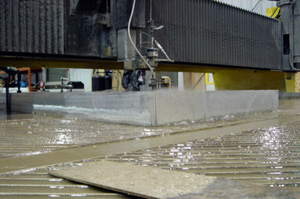
Waterjet cutting systems were not employed for commercial used until the 1970s. Since that time, these machines have been researched and redesigned to provide an assortment of models that better accommodate a variety of cutting requirements and materials.
Waterjet cutting machines can be organized into two, most basic categories:
Pure waterjet cutters provide the "blueprint” for which the operation of all other models are based upon.
In pure waterjet systems, an accelerated stream of water if forced through a narrow opening, compressing the water of pressures up to 60,000 pounds per square inch (psi). The opening is so defined that the diameter of the water is usually no more than 0.005 inches (0.1 millimetre).
Abrasive waterjet cutters operate under the same premises however, rather than using just water as the cutting solution, a mixture of abrasives and water is applied.
Pure waterjet machines are used for malleable materials such as:
-
Cardboard
-
Foam
-
Rubber
-
Leather
-
Food products
-
Plastic
Abrasive waterjet machines are use for firmer materials such as:
-
Marble
-
Stone
-
Metal
-
Bullet proof glass
-
Wood
-
Ceramic
There are two prevailing types of abrasive waterjet systems. Slurry abrasive waterjet machines and entrained waterjet cutters are the most well known types of waterjet cutting machines within the industry. However, entrainment models are greatly used over slurry systems, due to its advantage of more durable parts.
In slurry waterjet models, the abrasives are mixed with the water before it is pressurized. Therefore, the abrasives travel with the water, throughout the entire system of equipment. As a result, the parts of slurry systems are consumed significantly faster than those part of entrained systems.
Entrained waterjets restrict the mixing of abrasives in what is known as the mixing tube, or mixing chamber, after which, leave the waterjet nozzle and are directed at the workpiece. This process preserves the parts of entrained machines, improving longevity and performance.
A third, lesser known and less accessible abrasive system is gaining attention for its benefits in relation to stream lag and tapper. This model is known as a Dynamic waterjet cutter.
Stream lag refers to the decrease in power of the waterjet, from when it enters the workpiece and when it exits the workpiece, thereby completing the cut. Steam lag causes to issues of accuracy and taper.
Taper takes place as a result of stream lag. When the force of the water jet dwindles, cut errors like taper are likely to occur. Taper specifically refers to the cut error that appears as an undesired "V” shape in the workpiece.
While most waterjet systems are computer numerical controlled (CNC), Dynamic waterjet machines use CNC to calculate when and how to automatically tilt the waterjet head in order to prevent stream lag and taper.
Dynamic waterjet models automatically tilt the jet head to the side to avoid instances of taper. Likewise, to counteract stream lag, the waterjet head automatically tilts forward when needed.
Waterjet cutting machines are available in many models. Each model provides a set of performance capabilities, benefits, and also disadvantages. Depending on the needs and cutting style of the operator, the benefits of the appropriate waterjet model can far outweigh the disadvantages. Knowing the technology behind each machine type helps to eliminate the disadvantages and produce high quality results.